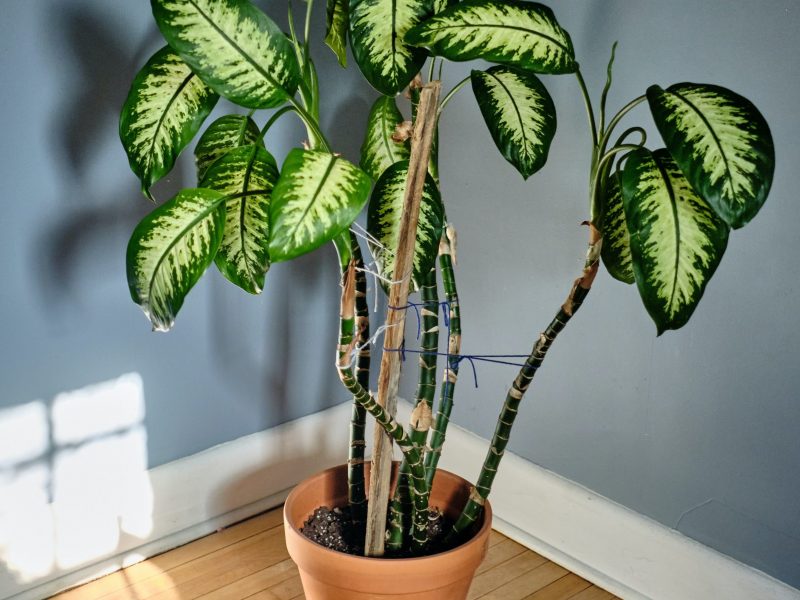
Known for being adaptable to different environments, Dumb Cane plants are great for most homes, however, this doesn’t mean that they aren’t susceptible to the same problems as all other plant types. One of the most common issues is your Dumb Cane losing leaves as this usually means that something isn’t right. It’s important to monitor the rate at which your plant is losing leaves. If it’s only a few leaves every few months (and this is less than the rate of new growth), then it can sometimes be just natural ageing which isn’t anything to worry about.
But if your plant is losing more than this, then it could mean that something is wrong with the care your Dumb Cane is getting, or the environment that it’s growing in.
Low temperatures
Extreme temperatures and drafts can be quite harmful to your Dumb Cane as they thrive in warm environments and this can definitely be why your Dumb Cane is losing leaves. Make sure your plant is not placed near doors or windows that may be drafty. Even though the temperature of your home may feel perfect for your Dumb Cane, any drafts coming in from the outside may be colder and harm your plant’s health.
This is particularly damaging during the long cold nights so we recommend picking up a digital thermometer to check the temperature across the day and night in various spots in your home. This will make sure that you don’t place your Dumb Cane in a spot that is too cold as this should fix the issue and you shouldn’t see any more leaves falling off. AC vents are another no-no for Dumb Cane plants as this constant stream of cold air can cause temperature stress and leaf drop.
Too much water
If you find that your Dumb Cane is starting to lose leaves from the bottom up, then it indicates that there is an issue with the root system, most commonly root rot. This is caused by consistent overwatering. Whilst your plant will 100% forgive you for the occasional overwatering, over time if the potting mix never gets an opportunity to dry out then it will cause the roots to turn soft and mushy.
Once the root system is damaged, your plant won’t be able to take up needed nutrients, water or oxygen which causes the leaves to drop as well as a lack of new growth and often yellow leaves.
If you think that your Dumb Cane is waterlogged, check the moisture of the soil immediately using a moisture meter and adjust watering accordingly. We also recommend replacing the potting soil straight away (rather than waiting for it to naturally dry out) so that the roots can begin to recover and resume healthy growth. Going forward, it’s important that you adjust your watering schedule and it’s a good idea to use the moisture meter to make sure you are only watering your Dumb Cane when it needs it.
Drainage Issues
Sometimes it may not be your watering schedule that is causing your Dumb Cane to lose its leaves, but the poor draining of the soil and pot. You can very easily increase the amount of drainage in your Dumb Cane by mixing in a small amount of perlite. This will not only help with the flow of water through the pot, but it also aids the aeration of the soil which is a bonus.
Terracotta pots are also great at helping with the drainage as the clay they’re made of is permeable which means that some of the water in your soil can evaporate through the sides of the pot. This isn’t the case for the plastic pots that you will usually buy your houseplants in, which instead hold in all of that moisture.
Overfertilisation
Most generic plant foods and fertilisers will recommend a dosage for your plants, but it’s often far too much for your Dumb Cane and can result in leaves being dropped. A lot of factors such as plant age, size and variety will impact how much and often you need to fertilise your houseplants and so one amount will never be suitable for every plant.
The best thing to do here is to try out feeding at half the recommended dosage and see how your Dumb Cane reacts. Try also decreasing the number of times you fertilise your Dumb Cane each year and this should help prevent more leaves from falling from your plant. You can also take a look at the root system to see if you can spot any fertiliser build up around the roots that might be affecting your plant.
Those are the three most common reasons why Dumb Cane / Dieffenbachia plants lose their leaves. It’s important that you find the issue that’s affecting your plant quickly to prevent the issue from progressing any further as it might then be too late to bring your plant back to full health and you might have to say goodbye to it.
Check out our Dumb Cane care guide for more information on how to best take care of your plant!














